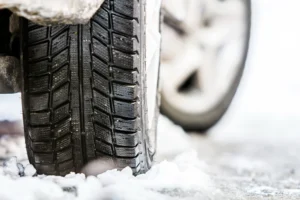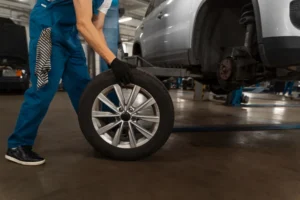When drivers notice vibrations, uneven tyre wear, or their car pulling to one side, they often assume the problem lies with wheel alignment or balancing. While both are essential for safe driving and tyre longevity, they are different procedures that address different issues. Understanding the difference between wheel balancing and wheel alignment will help you identify problems early and ensure your vehicle stays safe, smooth, and efficient on the road.
What is Wheel Balancing?
Wheel balancing ensures that the weight of the tyre and wheel assembly is evenly distributed around the axle. An imbalance causes vibrations, usually felt through the steering wheel, especially at higher speeds. This vibration not only makes driving uncomfortable but can also accelerate wear on tyres, suspension, and bearings.
During balancing, small counterweights are attached to the wheel rim to correct uneven distribution. Professional tyre fitters use specialised machines to detect imbalances and apply the precise correction. Wheel balancing is usually performed whenever new tyres are fitted or if you experience steering vibrations. Regular balancing improves ride comfort, reduces stress on suspension, and extends tyre life.
What is Wheel Alignment?
Wheel alignment, also called tracking, adjusts the angles of the wheels so they meet the road surface correctly. Poor alignment can cause tyres to wear unevenly, steering to pull to one side, or a crooked steering wheel. Misalignment often results from hitting potholes, kerbs, or general wear of suspension components.
Alignment is measured in three key angles:
- Toe: The direction tyres point relative to each other.
- Camber: The inward or outward tilt of tyres when viewed from the front.
- Caster: The angle of the steering pivot, affecting stability and cornering.
Correct wheel alignment ensures tyres wear evenly, handling remains precise, and fuel efficiency improves. Alignment should be checked annually or sooner if you notice uneven wear or changes in steering behaviour.
How They Differ
While balancing deals with weight distribution around the wheel and tyre, alignment focuses on the angles at which tyres meet the road. Balancing resolves vibrations and improves ride comfort, whereas alignment corrects steering issues and prevents uneven tyre wear. Both are necessary for overall vehicle safety and performance, but they target different problems.
In practice, balancing is often done during tyre fitting, while alignment requires specialist adjustment equipment. Neglecting either can lead to premature tyre wear, unsafe handling, and increased running costs.
Signs You Need Wheel Balancing
You may need wheel balancing if you notice:
- Vibrations through the steering wheel at certain speeds.
- Uneven wear across the tyre tread.
- A humming or buzzing noise from tyres.
If left unresolved, imbalanced wheels can shorten tyre life and damage suspension components.
Signs You Need Wheel Alignment
Common signs of misalignment include:
- Vehicle pulling to the left or right.
- Uneven or rapid tyre wear, especially on one edge.
- Steering wheel off-centre when driving straight.
Ignoring alignment issues leads to poor handling, increased tyre costs, and reduced fuel efficiency.
Preventing Problems
The best way to prevent balancing and alignment issues is through regular maintenance. Have your wheels balanced whenever new tyres are installed or if you experience vibrations. Schedule an alignment check annually, or after hitting kerbs, potholes, or other road hazards. Regular servicing of your suspension system also helps prevent alignment problems.
Conclusion
Wheel balancing and wheel alignment are often confused, but they play distinct roles in vehicle safety and performance. Balancing corrects uneven weight distribution to eliminate vibrations, while alignment ensures tyres meet the road at the correct angles for stable, efficient driving. By addressing both when needed, you can extend tyre life, improve fuel economy, and enjoy a smoother, safer journey.





